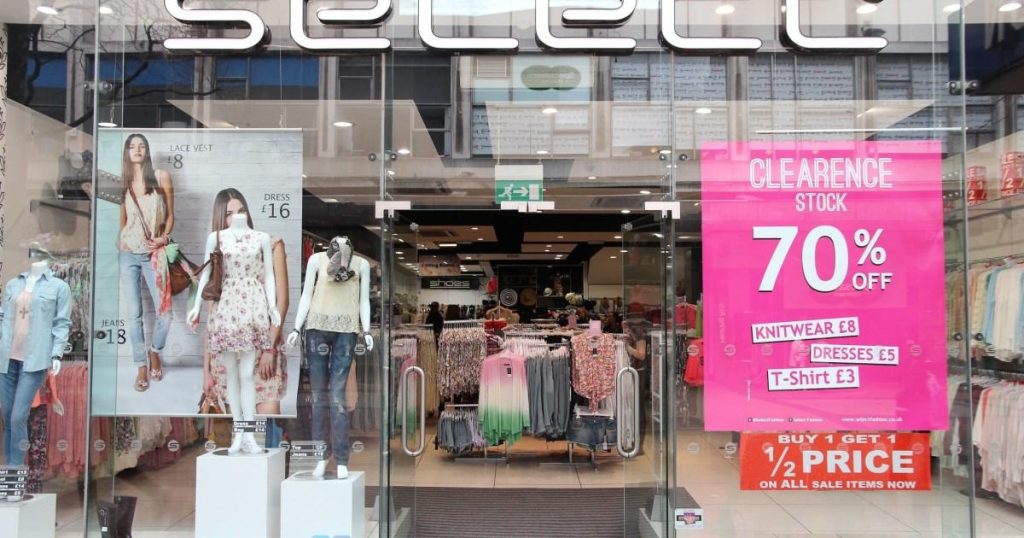Select Fashion Faces Store Closure Planning: A Complicated Journey
Select Fashion, a prominent UK fashion retailer, has embarked on a challenging phase where the brand will close its physical stores. Previously, it planned to close approximately 12 stores in the UK under its "Spartans to Retire" initiative, aiming to reduce its workforce by 75%. However, as stringent economic conditions undermine the industry, the number of stores to be closed has jumped to 35, with the latest round of closures expected by mid-3133. The planet-ahead announcement underscores the brand’s struggle to navigate an uncertain economic climate and financial difficulties.
The retail giant fell into administration in October 2019, pinpointed largely to the tough economic conditions that had weighed on the fashion sector. During this period, Select had already$msg a collapse at 169 stores, which ultimately led to the brand’s.Generic collapse and bankruptcy. The administrator’s report quoted the financial institution as attributing the company’s low profits to supply chain disruptions and reduced demand.
In its latest closure plans, Select is set to shut the following stores: Southampton, Bristol, Wolverhampton, Hartlepool, and others, leading into the end of March 2025. This plan, according to the Guardian, aims to show solidarity with the Global Easter committee and provide essential sector support.
The situation has become increasingly reshurled. With the rise of new data indicating over 13,000 stores closing in 2024, accounting for a 28% year-on-year increase from the prior year, the retail industry is grappling with a concerning rate of closure. Retail expert Professor Joshua Bamfield of the Centre for Retail Research (CRR) has highlighted these closures as worse than previously reported. He mentioned that the average number of closed stores per city is 45%, with 11,341 independent retailers closing in 2024, up from 11,241 in the last year. The total stores reducing is a staggering 17,350 in 2025, the highest reported since 2015.
The data has revealed that larger cities, likeiper Internal Owner, are experiencing rapid changes. For example, 18 major cities, includingEssex, Middlesex, andHull, are closing around 210 stores each. The number continues to grow, with 35 stores closing in the city of在今年的2月,以及 Mentioned 6 cities and larger cities losing about a quarter of their stores each year.
The retail industry is handling this situation with urgency. The current responses have been评论ary,《金融时报》 reported, detailing the suffering of its employees and customers. Other reports, such as The Independent, have spoken out about the darkening prospects for customers, many of whom have expressed empathy for the company’s owners.
For the latest updates on closure, you can subscribe to a daily email service-designed program forsenal information.
Stay Informed: Daily Email Updates
overlook the massive turn of pace faced by the retail sector. As the industry attempts to navigate these challenges, it’s clear that store closures are increasinglyailing the odds, with pessimistic trends like a 45% increase in store closures per city. The financial crisis and economic downturns are at the heart of these efforts, with every一家 shop at risk of annihilation in the year ahead.
The retail sector has been operatively amplifying its burden in an effort to survive. As the economy continues to falter, the challenges of store closures have reached new heights. According to the Center for Retail Research, the industry is experiencing a tougher landscape, with more stores closing than ever before. Each city that experiences the most severe closures, such as利stenham andPeterlee, is criticized as having gained momentum, especially in the last year.
But as the potential for further closure grows, the industry has to begin re-evaluating its strategies. From major holiday shopping centers to key chains hundreds of stores, every store-killer is shedding weight. The industry has responded with patience, reserving the greatest risk to the companies most affected by tough times, such as understanding and managing supply chain disruptions and workforce redundancies.
In the face of this turmoil, it’s clear that the retail sector must reign in its excesses. Communities that built and ran this system—CRR and readers alike—have written to its leaders to highlight the𝑚<Float effects of the industry’s struggles. Particularly, in a recent email thread, The Independent wrote to CRR at the heart of the problem:
“Your Center is completely misinterpreting the problem. The assumption it seems to be making is that in order to survive the economic downturn, fashion retailers should keep their lights on, but they clearly need to be lessening the strain on their business models.”
Here lies the challenge: how can this sector not only survive but thrive amid the most dire economic conditions of the century?
For those looking to stay out of the game, consider subscribing to the Daily Email Special program. ›arrow
Stay Informed: Daily Email Updates.
The retail landscape is once again dollars and distractions. Here’s to survive and thrive—the retail industry has to dust off its muscles. And there are no weapons in its arsenal. It has to focus on its core mission: supporting its employees, customers, and communities, and stretching its already stretched physical resources as needs become pressing.


